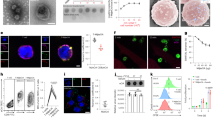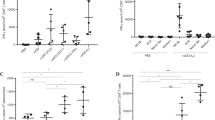Abstract
In many common cancers, dissemination of secondary tumors via the lymph nodes poses the most significant threat to the affected individual. Metastatic cells often reach the lymph nodes by mimicking the molecular mechanisms used by hematopoietic cells to traffic to peripheral lymphoid organs. Therefore, we exploited naive T cell trafficking in order to chaperone an oncolytic virus to lymphoid organs harboring metastatic cells. Metastatic burden was initially reduced by viral oncolysis and was then eradicated, as tumor cell killing in the lymph node and spleen generated protective antitumor immunity. Lymph node purging of tumor cells was possible even in virus-immune mice. Adoptive transfer of normal T cells loaded with oncolytic virus into individuals with cancer would be technically easy to implement both to reduce the distribution of metastases and to vaccinate the affected individual in situ against micrometastatic disease. As such, this adoptive transfer could have a great therapeutic impact, in the adjuvant setting, on many different cancer types.
This is a preview of subscription content, access via your institution
Access options
Subscribe to this journal
Receive 12 print issues and online access
$209.00 per year
only $17.42 per issue
Buy this article
- Purchase on Springer Link
- Instant access to full article PDF
Prices may be subject to local taxes which are calculated during checkout






Similar content being viewed by others
References
Markovic, S.N. et al. Malignant melanoma in the 21st century, part 2: staging, prognosis and treatment. Mayo Clin. Proc. 82, 490–513 (2007).
Chang, G.J., Rodriguez-Bigas, M.A., Skibber, J.M. & Moyer, V.A. Lymph node evaluation and survival after curative resection of colon cancer: systematic review. J. Natl. Cancer Inst. 99, 433–441 (2007).
Benson, J.R., della Rovere, G.Q. & Group, A.M.C. Management of the axilla in women with breast cancer. Lancet Oncol. 8, 331–348 (2007).
Beri, A. & Janetschek, G. Radioguided sentinel lymph node dissection in the staging of prostate cancer. Nat. Clin. Pract. Urol. 3, 602–610 (2006).
Kim, R., Emi, M., Tanabe, K. & Arihiro, K. Immunobiology of the sentinel lymph node and its potential role for anti tumor immunity. Lancet Oncol. 7, 1006–1016 (2006).
Munn, D.H. & Mellor, A.L. The tumor draining lymph node as an immune privileged site. Immunol. Rev. 213, 146–158 (2006).
Matsuura, K. et al. Maturation of dendritic cells and T cell responses in sentinel lymph nodes from patients with breast carcinoma. Cancer 106, 1227–1236 (2006).
Murta, E.F., Andrade, J.M., Falcao, R.P. & Bighetti, S. Lymphocyte subpopulations in patients with advanced breast cancer submitted to neoadjuvant chemotherapy. Tumori 86, 403–407 (2000).
Arnould, L. et al. Trastuzumab-based treatment of HER2-positive breast cancer: an antibody-dependent cellular cytotoxicity mechanism? Br. J. Cancer 94, 259–267 (2006).
Walker, L.S.K. & Abbas, A.K. The enemy within: keeping self-reactive T cells at bay in the periphery. Nat. Rev. Immunol. 2, 11–19 (2002).
Thomas, D.A. & Massague, J. TGF-beta directly targets cytotoxic T cell functions during tumor evasion of immune surveillance. Cancer Cell 8, 369–380 (2005).
Harrington, K. et al. Cells as vehicles for cancer gene therapy: the missing link between targeted vectors and systemic delivery? Hum. Gene Ther. 13, 1263–1280 (2002).
Crittenden, M. et al. Pharmacologically regulated production of targeted retrovirus from T cells for systemic antitumor gene therapy. Cancer Res. 63, 3173–3180 (2003).
Chester, J. et al. Tumor antigen–specific induction of transcriptionally targeted retroviral vectors from chimeric immune receptor-modified T cells. Nat. Biotechnol. 20, 256–263 (2002).
Cole, C. et al. Tumor-targeted, systemic delivery of therapeutic viral vectors using hitchhiking on antigen-specific T cells. Nat. Med. 11, 1073–1081 (2005).
Kottke, T. et al. The perforin-dependent immunological synapse allows T-cell activation–dependent tumor targeting by MLV vector particles. Gene Ther. 13, 1166–1177 (2006).
Thanarajasingam, U. et al. Delivery of CCL-21 to metastatic disease improves the efficacy of adoptive T-cell therapy. Cancer Res. 67, 300–308 (2007).
Thorne, S.H., Bartlett, D.L. & Kirn, D.H. The use of oncolytic vaccinia viruses in the treatment of cancer: a new role for an old ally? Curr. Gene Ther. 5, 429–443 (2005).
Power, A.T. et al. Carrier cell–based delivery of an oncolytic virus circumvents antiviral immunity. Mol. Ther. 15, 123–130 (2007).
Ong, H.T., Hasegawa, K., Dietz, A.B., Russell, S.J. & Peng, K.W. Evaluation of T cells as carriers for systemic measles virotherapy in the presence of antiviral antibodies. Gene Ther. 14, 324–333 (2007).
Yotnda, P., Savoldo, B., Charlet-Berguerand, N., Rooney, C. & Brenner, M. Targeted delivery of adenoviral vectors by cytotoxic T cells. Blood 104, 2272–2280 (2004).
Morgan, R.A. et al. Cancer regression in patients after transfer of genetically engineered lymphocytes. Science 314, 126–129 (2006).
Peters, A.M. The use of nuclear medicine in infections. Br. J. Radiol. 71, 252–261 (1998).
Shields, J.D. et al. Chemokine-mediated migration of melanoma cells towards lymphatics a mechanism contributing to metastasis. Oncogene 26, 2997–3005 (2007).
Takeuchi, H. et al. CCL21 chemokine regulates chemokine receptor CCR7 bearing malignant melanoma cells. Clin. Cancer Res. 10, 2351–2358 (2004).
Wiley, H.E., Gonzalez, E.B., Maki, W., Wu, M. & Hwang, S.T. Expression of CC chemokine receptor-7 and regional lymph node metastasis of B16 murine melanoma. J. Natl. Cancer Inst. 93, 1638–1643 (2001).
Weninger, W. & von Andrian, U.H. Chemokine regulation of naive T cell traffic in health and disease. Semin. Immunol. 15, 257–270 (2003).
Kelly, E. & Russell, S.J. History of oncolytic viruses: genesis to genetic engineering. Mol. Ther. 15, 211–219 (2007).
Stojdl, D.F. et al. VSV strains with defects in their ability to shutdown innate immunity are potent systemic anti-cancer agents. Cancer Cell 4, 263–275 (2003).
Fernandez, M., Porosnicu, M., Markovic, D. & Barber, G.N. Genetically engineered vesicular stomatitis virus in gene therapy: application for treatment of malignant disease. J. Virol. 76, 895–904 (2002).
Balachandran, S., Porosnicu, M. & Barber, G.N. Oncolytic activity of vesicular stomatitis virus is effective against tumors exhibiting aberrant p53, Ras, or myc function and involves the induction of apoptosis. J. Virol. 75, 3474–3479 (2001).
Balachandran, S. & Barber, G.N. Vesicular stomatitis virus therapy of tumors. IUBMB Life 50, 135–138 (2000).
Shinozaki, K., Ebert, O. & Woo, S.L. Eradication of advanced hepatocellular carcinoma in rats via repeated hepatic arterial infusions of recombinant VSV. Hepatology 41, 196–203 (2005).
Ebert, O., Harbaran, S., Shinozaki, K. & Woo, S.L. Systemic therapy of experimental breast cancer metastases by mutant vesicular stomatitis virus in immune-competent mice. Cancer Gene Ther. 12, 350–358 (2005).
Stojdl, D.F. et al. Exploiting tumor-specific defects in the interferon pathway with a previously unknown oncolytic virus. Nat. Med. 6, 821–825 (2000).
Lun, X. et al. Effects of intravenously administered recombinant vesicular stomatitis virus on multifocal and invasive gliomas. J. Natl. Cancer Inst. 98, 1546–1557 (2006).
Diaz, R.M. et al. Oncolytic immunovirotherapy for melanoma using vesicular stomatitis virus. Cancer Res. 67, 2840–2848 (2007).
Lichty, B.D. et al. Vesicular stomatitis virus: a potential therapeutic virus for the treatment of hematologic malignancy. Hum. Gene Ther. 15, 821–831 (2004).
Thirukkumaran, C.M., Russell, J.A., Stewart, D.A. & Morris, D.G. Viral purging of haematological autografts: should we sneeze on the graft? Bone Marrow Transplant. 40, 1–12 (2007).
Engelhorn, M.E. et al. Autoimmunity and tumor immunity induced by immune responses to mutations in self. Nat. Med. 12, 198–206 (2006).
Linardakis, E. et al. Enhancing the efficacy of a weak allogeneic melanoma vaccine by viral fusogenic membrane glycoprotein–mediated tumor cell–tumor cell fusion. Cancer Res. 62, 5495–5504 (2002).
Dyall, R. et al. Heteroclitic immunization induces tumor immunity. J. Exp. Med. 188, 1553–1561 (1998).
Hogquist, K.A. et al. T cell receptor antagonist peptides induce positive selection. Cell 76, 17–27 (1994).
Altman, D.G. Analysis of survival times. in Practical Statistics for Medical Research (Ed. Altman, D.G.) 365–395 (Chapman and Hall, London, 1991).
Acknowledgements
We thank T. Higgins for expert secretarial assistance. This work was supported by the Mayo Foundation and by US National Institutes of Health grant CA RO1107082-02.
Author information
Authors and Affiliations
Contributions
J.Q., T.K., C.W., F.G., P.W., R.M.D. and R.G.V. conducted most of the experiments; J.T. and P.R., conducted the in vivo experiments. G.N.B. developed the VSV virus used in these studies; J.C., P.S., K.H., A.M. and R.G.V. designed the project and developed its theoretical basis. J.Q., K.H., A.M. and R.G.V. wrote the manuscript.
Corresponding author
Rights and permissions
About this article
Cite this article
Qiao, J., Kottke, T., Willmon, C. et al. Purging metastases in lymphoid organs using a combination of antigen-nonspecific adoptive T cell therapy, oncolytic virotherapy and immunotherapy. Nat Med 14, 37–44 (2008). https://doi.org/10.1038/nm1681
Received:
Accepted:
Published:
Issue Date:
DOI: https://doi.org/10.1038/nm1681
This article is cited by
-
Tumor-specific delivery of biologics by a novel T-cell line HOZOT
Scientific Reports (2016)
-
Oncolytic viruses—immunotherapeutics on the rise
Journal of Molecular Medicine (2016)
-
Chimeric antigen receptor–engineered T cells as oncolytic virus carriers
Molecular Therapy - Oncolytics (2015)
-
Cytokine Conditioning Enhances Systemic Delivery and Therapy of an Oncolytic Virus
Molecular Therapy (2014)
-
The Profile of Tumor Antigens Which Can be Targeted by Immunotherapy Depends Upon the Tumor's Anatomical Site
Molecular Therapy (2014)



